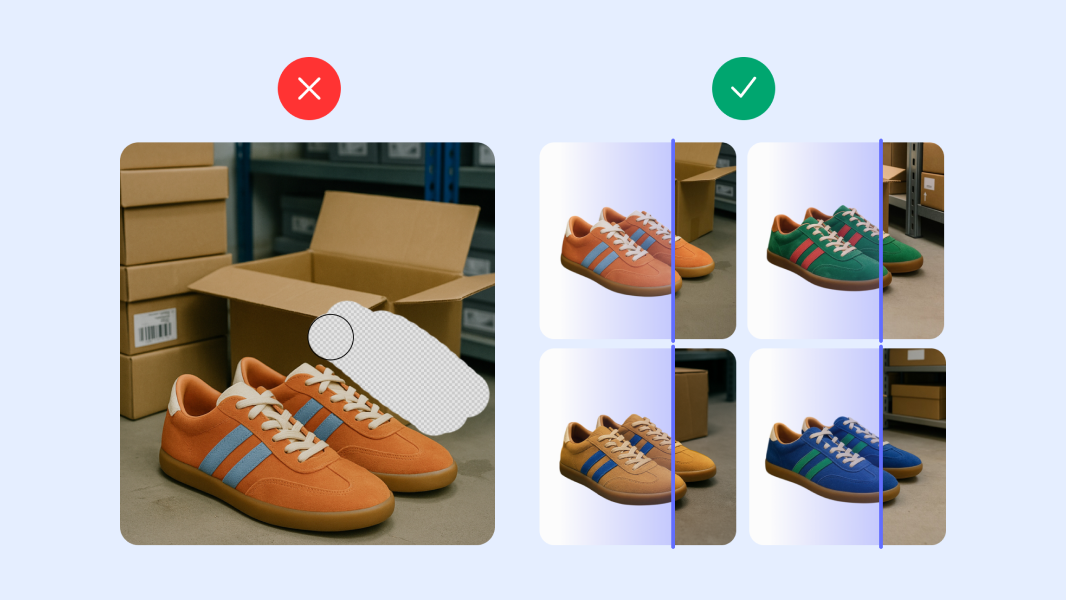How AI is elevating marketplace imagery for the next generation
In the transformative landscape of e-commerce, marketplaces are at a pivotal juncture. In the article “Marketplace in the age of AI” Olivia Moore from Andreessen Horowitz, a leading investor in marketplaces like Airbnb, Instacart, and Postmates highlights one shift happening with AI for Marketplaces: the move from prioritizing quantity to emphasizing quality in product listings visuals. This evolution, made possible by AI, marks a critical transition for marketplaces dealing in physical goods.
Quality and quantity: the new marketplace paradigm
Previously, the focus was on listing as many products as possible, adhering to the principle that more is better, also named the 'long tail' in the e-commerce industry. The long tail in e-commerce refers to the phenomenon where a significant portion of sales comes from items that are not bestsellers or best-known products. This concept was popularized by Chris Anderson in his book “The Long Tail: Why the Future of Business Is Selling Less of More.” The long tail strategy focuses on selling low volumes of specialized products to many customers, rather than high volumes of a reduced number of popular items.
It allows companies to realize significant profits by catering to niche markets and offering a wide variety of products. The long tail theory is based on the idea that the internet and online marketplaces have made it possible to stock and distribute many niche products, allowing businesses to capitalize on the demand for less popular items. In the past, whilst the focus was on quantity, visuals, and imagery uploaded by the sellers were only required to fit Marketplace guidelines. However, with the saturation of marketplaces and the ease for sellers to list across multiple platforms, fierce competition has emerged with multiple marketplaces selling the same items. The differentiator? High-quality photography. Unlike before, where simplicity and volume were key, today's marketplaces need to present products in the best light possible— and differentiate.
The AI revolution in marketplace imagery
Traditionally, marketplaces operating on thin margins, found it challenging to invest in product image. The process of creating professional product images was cumbersome, slow, and costly. Now, AI has changed the game. Sellers can easily achieve professional-grade product photography, and marketplaces can leverage AI-powered APIs to process images efficiently, ensuring image consistency and reducing scrolling fatigue.
How AI transforms marketplace listings visuals
Streamlining the listing process: AI allows sellers to upload images in any format, which are then automatically resized to fit marketplace dimensions. Image editing APIs like Photoroom’s enable the editing of images taking into account the different needs of different categories or origins. This eliminates issues with irregular product dimensions and unappealing backgrounds.
Enhancing visual appeal: Through AI, marketplaces can avoid visuals with bland white backgrounds. APIs enable the addition of dynamic AI generated backgrounds, shadows, and lighting enhancements, making it easier for sellers to capture buyers' attention with visually compelling listings.
Creating themed visuals: Instantly and effortlessly, AI can generate themed visuals for specific categories or pages, enriching the browsing experience and making listings more attractive.
Supercharged ad asset creation: Marketplaces were often limited in the number of ads they could create based on the images provided by sellers. With APIs such as Photoroom's Image Editing API, a marketplace can generate unlimited ad combinations they can test and yield better results. To better understand the impact of images on ad performance, Photoroom conducted a Facebook ad A/B/C test using different ad photo variants, which they created with our Gen AI backgrounds and shadows. They observed a 34% improvement with the Gen AI ad image variant.

Who foots the bill for photo editing in marketplaces?
The debate over who should cover the cost of photo editing for listing products on marketplaces is significant.
On one hand, sellers are encouraged to invest in quality photography to stand out. Marketplaces can facilitate this by partnering with photo editing services, like Photoroom, offering sellers a link to a Photoroom Marketplace partnership page, where sellers can edit their images at no additional cost to the marketplace. This approach may lead to better imagery, yet it won’t solve all problems, as it will remain a choice and an effort of the seller.
On the other hand, marketplaces investing in photo editing can significantly differentiate themselves in a crowded market. The argument for marketplaces absorbing the cost of photo-editing is significantly bolstered by the fierce competitiveness of the online retail environment. In a landscape where consumers are inundated with choices, compelling visuals and competitive pricing become paramount in influencing user engagement—from the initial advertisement click-through to the decisive moment of product selection on a category page. Quality images transcend mere aesthetics; they build consumer trust in a product, often tipping the balance in favor of purchase decisions over textual descriptions.
For marketplaces aiming to differentiate themselves, especially to audiences beyond their regular user base, investment in high-caliber photography is not just beneficial—it's crucial. The success stories of premium marketplaces like Farfetch, Harrods, Vestiaire Collective, and StockX underscore this point, demonstrating that exceptional photography is a consistent factor behind their achievements. This evidence suggests that for marketplaces looking to carve out a distinctive identity in a crowded market, financing photo-editing services could be a strategic move to enhance product visibility and appeal, thereby fostering a stronger connection with consumers. AI-driven solution proposes the use of specific APIs, such as those from remove.bg or Photoroom, tailored for editing main images on category pages. This strategy aims to maintain minimal costs while ensuring visual consistency, with services like Photoroom's API offering background removal and image cropping at minimal cost (rate of $0.02 per image).
The competitive edge of premium imagery
In the fiercely competitive arena of online marketplaces, visuals often dictate consumer choices. Premium marketplaces, known for their impeccable photography, were the leader in showing the importance of high-quality images in attracting customers. This is not just about aesthetics; it's about trust and confidence in the product being offered. With AI, the same results can be achieved at scale, whilst keeping the budget affordable for marketplaces operating with thin margins.
AI's role in marketplace evolution
AI is not just reshaping how products are presented; it's redefining the entire marketplace experience. From streamlining operations to optimizing listings on platforms like Amazon, AI is instrumental in enhancing product descriptions, improving visibility, and ultimately, boosting conversion rates. The ability for consumers to use natural language or images to find what they're looking for simplifies the search process, reducing the time from inspiration to purchase.
In conclusion: embracing the AI-driven future
The transition to AI-enhanced marketplace listings is not just an option; it's a necessity for staying competitive. By investing in quality imagery, either through seller initiatives or marketplace-driven efforts, platforms can significantly improve the shopping experience. This not only attracts more buyers but also fosters a sense of trust and reliability in the marketplace.
As we navigate this AI-driven era, the focus must remain on delivering an exceptional user experience through quality listings and optimized visuals. The journey from quantity to quality is not just a shift in strategy but a commitment to excellence and customer satisfaction in the ever-evolving world of e-commerce.
Marketplace leaders, the challenge is clear: adapt and innovate with AI to enhance your platform's visual appeal and operational efficiency. The future of marketplaces will be with AI, in embracing AI for streaming image quality, you're staying ahead of the competition.
Related articles:




Design your next great image
Whether you're selling, promoting, or posting, bring your idea to life with a design that stands out.

















